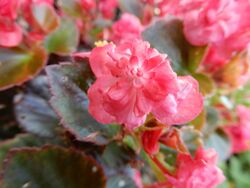Biology:Begonia cucullata
| Begonia cucullata | |
|---|---|

| |
| Scientific classification | |
| Kingdom: | Plantae |
| Clade: | Tracheophytes |
| Clade: | Angiosperms |
| Clade: | Eudicots |
| Clade: | Rosids |
| Order: | Cucurbitales |
| Family: | Begoniaceae |
| Genus: | Begonia |
| Species: | B. cucullata
|
| Binomial name | |
| Begonia cucullata Carl Ludwig Willdenow, 1805
| |
| Synonyms | |
|
Begonia cucullata var. cucullata | |
Begonia cucullata, also known as clubbed begonia,[1][2][why?] is a species of the Begoniaceae that is native to South American countries of Argentina , Brazil , Paraguay, and Uruguay.[3] A common garden plant and part of the section Begonia, it was described in 1805 by Carl Ludwig Willdenow (1765–1812). The specific epithet "cucullata" means "resembling a hood" or "hooded".[4]
Description
The plant is an upright growing, herbaceous perennial that has almost symmetrical succulent pale green to pale reddish brown leaves that are ovate, glabrous 4–8 cm long and 6 cm wide, with edged, glossy and toothed crenation.[5] Grown as a groundcover, the flowers of the plant are red, pink or white that bloom in the summer or year-round in warmer places, and the fruits have three wings.[6][7]
Range
Native to South America, wax begonia is also found growing invasively in Florida, namely from the northern and central peninsula west to central panhandle, and also in Georgia. The plant may invade waysides, deforested areas, overgrazed pastureland, and wastelands.[8]
Because they are such prolific seed producers, seeds are thought to be the primary way begonias spread when left unchecked. They can also root very easily, but this may not play much of a role under natural conditions.[9]
Cultivation
Older varieties prefer shade, though newer varieties tolerate both full sun and shade. Indoors, they can thrive in a south- or east-facing window, provided they are acclimated when their environment is changed.[10]
Varieties
Begonia × semperflorens-cultorum, marketed commercially as the wax begonia, is a hybrid of at least five species, including B. cucullata.[11] The name wax begonia refers to the thick and waxy leaves of the group.[12]
According to Catalog of Life (February 6, 2017) 6 and Kew Garden World Checklist, these varieties exist:[13][14]
- Begonia cucullata var. cucullata
- Begonia cucullata var. hookeri (A.DC.) LBSm. & BGSchub. (1941)
- Begonia cucullata var. spatulata (G.Lodd. ex Haw.) Golding (1982)
- Begonia cucullata var. subcucullata (C.DC.)
According to Tropicos (February 6, 2017):[15]
- Begonia cucullata var. arenosicola (C. DC.) LB Sm. & BG Schub.
- Begonia cucullata var. cucullata
- Begonia cucullata var. hookeri LB Sm. & BG Schub.
- Begonia cucullata var. sellowii A. DC.
- Begonia cucullata var. spatulata (Lodd.) Golding
- Begonia cucullata var. subcucullata (C. DC.) ined.
Gallery
References
- ↑ "Begonia cucullata Willd.". Species. GBIF. http://www.gbif.org/species/2874717.
- ↑ "Begonia cucullata Willd." The PLANTS Database. Natural Resources Conservation Service. United States Department of Agriculture. Retrieved 25 April 2022.
- ↑ Begonia cucullata
- ↑ Begonia cucullata
- ↑ database, NODC Taxonomic Code, 1996
- ↑ Begonia cucullata – Wax Begonia
- ↑ "(Canada);http://siit.conabio.gob.mx (Mexico) ITIS Regional: The Integrated Taxonomic Information System". http://www.itis.gov;http/.
- ↑ Begoniaceae of North America Update
- ↑ "Begonia cucullata". University of Florida Institute of Food and Agricultural Sciences. n.d.. https://plants.ifas.ufl.edu/plant-directory/begonia-cucullata/.
- ↑ Langeland, K.A. and K. Craddock Burks. 1998. Identification and Biology of Non-Native Plants in Florida’s Natural Areas. IFAS Publication SP 257. University of Florida, Gainesville. 165 pp.
- ↑ Pounders, Cecil T.; Sakhanokho, Hamidou F.; Nyochembeng, Leopold M. (January 2015). "Begonia ×semperflorens FB08-59 and FB08-163 Clonal Germplasm". HortScience 50 (1): 145–146. doi:10.21273/HORTSCI.50.1.145.
- ↑ "Semperflorens (ever-blooming)". American Begonia Society. July 2021. https://www.begonias.org/semperflorens-ever-blooming/.
- ↑ Begonia cucullata Willd.
- ↑ Roskov Y.; Kunze T. (2014). "Species 2000 & ITIS Catalogue of Life: 2014 Annual Checklist.". in Didžiulis V.. Species 2000: Reading, UK.. http://www.catalogueoflife.org/annual-checklist/2014/details/species/id/11783285.
- ↑ database, The PLANTS Database, 1996
Wikidata ☰ Q6395156 entry
 |





